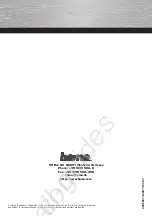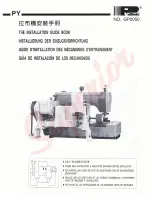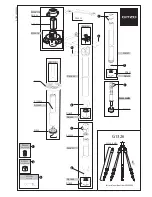
V E N T I L A T I O N & H E A T R E C O V E R Y
INSTALLATION INSTRUCTIONS AND
USER GUIDE
Part no. 744011EN, Week 47/2019 EN
External wireless humidity sensor
M-WRG-II FSF
1
2
3
Fig. 1: External wireless humidity sensor
Description
1
Control button (touch-sensitive)
2
Status LED
3
Mode LEDs (5x)
1
Introduction
1.1 Notes on these instructions
These instructions contain important information that
should be followed when installing and using the wire-
less humidity sensor.
►
Read all the instructions carefully to avoid possible risks and
mistakes.
►
These instructions are part of the product. Keep the instructions
in a safe place for future reference.
NOTICE
►
When operating the ventilation unit, also follow the operating
instructions that were supplied with your unit.
1.2 Description
The wireless humidity sensor is used for wireless operation of
ventilation units from the M-WRG-II and M-WRG series constructed
from 2020 onwards (excluding bus unit types). It can also be used
to determine the humidity level at an installation location selected
by you, provided that it is within the wireless range. The “Humidity
control” and “Automatic mode” ventilation programs use the
transmitted values to automatically adjust the unit’s air flow to the
required ventilation level. One wireless humidity sensor may be
linked to each ventilation unit. If the ventilation unit has an internal
humidity sensor, it will be automatically disabled. The wireless
humidity sensor incorporates the humidity control function into
ventilation units without an internal humidity sensor. The control
button (item 1 in Fig. 1) is used to activate five different ventilation
levels/programs. The current selection is indicated by one of the
five green mode LEDs (item 3 in Fig. 1). The multi-coloured status
LED (item 2 in Fig. 1) signals the wireless sensor and ventilation
unit operating statuses. If the relative room air humidity exceeds
60 % RH (factory setting) in the “Humidity control” or “Automatic
mode” ventilation program, the ventilation level is increased contin-
uously up to max. 60 m
3
/h until the humidity in the room drops back
below 60 % RH.
The wireless sensor is fixed to the wall with the dowels and screws
The optional M-WRG-FBH wireless remote control, part no. 5478-10,
can be used to program the functions of the wireless sensor. You
will find more details in the “User guide for wireless remote control
M-WRG-FBH”. The wireless humidity sensor can also be used in
parallel with the M-WRG-FBH wireless remote control, M-WRG-FT
4-way wireless pushbutton switch and M-WRG-II FSC wireless CO
2
sensor and in conjunction with the U
2
installation version and all
M-WRG-II and M-WRG covers.
1.3 Target group
These instructions are intended for users of the wireless humidity
sensor. No special prior knowledge is needed.
1.4 EU declaration of conformity
The wireless humidity sensor described below
Type: M-WRG-II FSF
Part number: 733010
manufactured by
Meltem Wärmerückgewinnung GmbH & Co. KG
Am Hartholz 4
82239 Alling
conforms to the regulations and standards listed in the EU Declara
-
tion of Conformity.
1.5 Technical data
Product characteristics
Dimensions (W x H x D)
100 mm x 100 mm x 25 mm
Weight
approx. 125 g
Colour
white, similar to RAL 9010
Material of the plastic parts
ABS
Ambient conditions
Ambient temperature during
operation
0 °C to 40 °C
Ambient temperature for storage and
shipping
-20 °C to 40 °C
Relative humidity
0 % to 90 %,
non-condensing
IP code (IEC 60529)
IP30
Battery
Size
AA, Mignon
Lifetime
approx. 2 years
Wireless connection
Communication frequency
868.3 MHz
Output power
at least 0 dBm
Data logging
Measurement range
0 % to 100 % RH
Measurement accuracy
at 11 % to 89 % RH
3 % RH
Measurement resolution
1 % RH
Measurement stability over 5 years
1.5 % RH
1.6 Environmentally-friendly disposal
The components of the wireless humidity sensor must not be
disposed of in the residual waste bin.
►
In Germany, metal and plastic components should be disposed
of at the local recycling centre. The national regulations in other
EU states should also be followed.
►
In Germany, electrical components should be disposed of in
accordance with the Electrical and Electronic Equipment Act
(ElektroG). In other EU states, the national implementation of the
Waste Electrical and Electronic Equipment Directive 2012/19/EU
(WEEE) should be followed.
►
In Germany, rechargeable batteries and accumulators should
be disposed of in accordance with the Batteries Act (BattG). The
national implementation of the Battery Directive 2006/66/EC
should be followed in other EU states.
►
The regulations and statutory requirements in your own country
concerning disposal should also be followed.
1.7 Explanation of the symbols used
►
This symbol indicates an action to be taken.
— This symbol indicates a list.
2
Safety
The wireless humidity sensor is approved only for use in dry interior
areas and must be protected against humidity and moisture to
prevent short-circuits.
2.1 Notes on operation
This unit may be used by children from 8 years old and by persons
of restricted physical, sensory or mental abilities or persons lacking




















